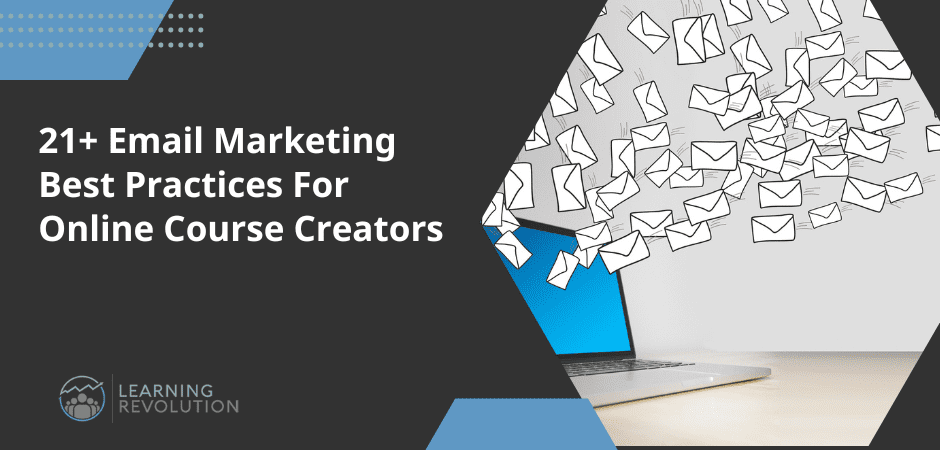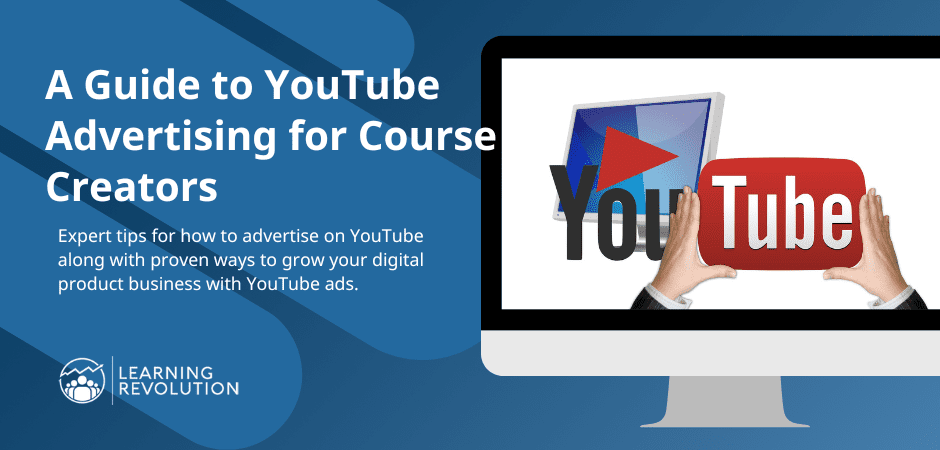

Email marketing is the most effective marketing tool that many edupreneurs and expertise-based businesses are under-using. Yes, most realize that they need to have an email marketing platform, but that’s not the same thing as knowing how to build an email marketing list and implement an effective email marketing strategy.
According to Fourth Source, 92 percent of internet users have at least one email account. By 2018, over half the world’s population used email, with 4.2 billion people expected to have an email account by 2022.
The sheer number of people who have access to email gives email marketing an advantage over social media. Facebook is the most dominant social platform, with 2.38 billion active monthly users, far eclipsing Instagram (1 billion), Twitter (262 million), and LinkedIn (260 million), but even combined they don’t come close to the number of people using email. And while 80 percent of internet users have at least one social media account, that number is split across all the different networks available. Put simply, email is the lowest common denominator for your entire online audience.
Email has other marketing advantages beyond volume alone. Your reach (the number of people who see your content) on social media is deliberately throttled in order to encourage you to pay to promote your posts. The organic reach of a Facebook Page post is only around 6.4 percent, whereas marketing emails are delivered to 85 percent of recipients. That means if you have a thousand fans on Facebook, only 64 will see your posts, but 850 emails will be successfully delivered from a mailing list of the same size. That makes mailing lists more than 13 times more effective at delivering your message than social media.
Once your message has been seen, email is also better at converting into a sale. Management consulting firm McKinsey & Company found that mailing lists generated 40 times more customers than social media outreach, and leads converted three times faster through email than social media. In fact, email marketing has a 4400 percent Return on Investment (ROI), meaning for every dollar you spend on email campaigns, you can bring in $44 income.
As an edupreneur, your email list is an unbeatable way to connect with interested learners and convert them into students of your courses. Mailing lists are also a great way to keep up with past learners, and maintain interest in your teaching at times when you don’t have a new course available.
The foundation of your email marketing strategy
Always remember: the most important part of building an email list is attracting the right subscribers. That means subscribers who are interested in you, your courses, and your subject. So, as your very first move, before you even begin trying to sign up subscribers, put some serious thought into the “why” of your e-mail list. In other words, put yourself in the shoes of your potential subscribers and ask: “Why would I sign up for this list?”
Almost no one is complaining of getting too little e-mail, so you really need to think about how you will deliver value to your subscribers over time. Will you deliver weekly, or even daily tips? Will you craft longer e-mails that offer perspectives on trends your subscribers care about? Will you simply update people when you publish a new blog post?
What will people be able to do or do better as a result of signing up for your list?
Whatever your “why” turns out to be, make sure you state it as concisely as possible wherever you ask for sign ups (more on that below). The value you offer has to be crystal clear if you expect people to fork over an e-mail address.
How to get subscribers for your email list
Once you’ve got your “why” figured out, you’re obviously going to have to attract subscribers if you want to build an email list.
First, don’t be discouraged if you see other edupreneurs or industry figures boasting tens of thousands of subscribers. Every mailing list will start with a single subscriber and grow steadily as you promote it.
And, don’t be tempted to purchase email addresses or pre-built lists to jumpstart your efforts. Not only will you run afoul of spam laws , you’ll risk getting booted off of your e-mail service provider and having all your data deleted – definitely not a great way to build an e-mail list!
Once you have your “why,” an obvious place to look for subscribers is your existing contacts. If you’ve got the email addresses of past subscribers, colleagues, or acquaintances who would be interested in your courses, invite them to sign up – and, of course, this is where being able to clearly state your “why” is critical.
Caution: definitely do not just sign these people up yourself. Not even if you feel you have a great relationship with them. Not even if it’s your mom. There’s nothing more annoying than being opted into a mailing list without being asked, and it’s a fast track to getting marked as spam. (Hopefully your mom won’t do that, but you never know!)
Once you’ve reached out to your existing contacts, it’s time to find new ones. Mailing list services and many website content management systems (WordPress, Wix, etc.) and the best online course platforms have the functionality to add embedded forms into your site(s) to collect email addresses from subscribers and automatically add them to your mailing list. You should ensure there’s an embedded form, or a pinned post with a link to your signup page, anywhere you have an online presence, including on your social media.
Passive lead generation can produce a trickle of new subscribers, but for the next step you have to actively recruit. Remember mailing lists have the best ROI, so if you’ve got a limited budget for advertising and promotion, it’s better spent here than on Facebook or Google Ads. There are a number of ways of actively recruiting new signups, and you should consider which methods will work best for you.
Blogging
Maintaining a regular blog is a great way to generate interest in your field and your courses. A blog can demonstrate your knowledge and expertise in your subject, and naturally attracts people who are interested in learning more. If they respect your opinion and consider you an authority in your field, they’re more likely to convert into learners for courses you launch. Basically, the benefits of blogging to build an email list are huge.
The downside to blogging is the time commitment involved in creating new content on a consistent basis. Blog posts can be scheduled, meaning it might be easier for you to write five or six posts in a day and queue them for the next month or more rather than regularly producing new posts, but some edupreneurs still lack the time or don’t want to make that kind of ongoing commitment to their promotional efforts.
Blogging can also be difficult for those who struggle to express themselves concisely in writing, or whose subject matter can’t fit easily into a WordPress template. If you can’t produce consistent, easy to follow posts on a regular basis, for whatever reason, blogging might not be the best option for you.
Guest posting
A guest post is essentially a blog post published on a website other than yours. Many fields already have a thought leader or flagship site that needs to generate quality content on a regular basis, and often they’re open to hosting guest posts from others. Appearing on a large website can promote you more effectively than trying to start from scratch with your own site, because your target audience already visits that site and trusts the opinions of the people writing on it.
Few sites will let you host a mailing list signup directly on their platform, but you should get a byline with a link. You can (and should!) point that to a signup form on your website, ideally on a page that will that provides a valuable download or access to a video – as covered in the next few sections – in exchange for submitting an e-mail address.
Ebooks
It probably seems that everyone is writing an ebook these days, but there’s a valid reason for that—they’re great promotional tools. With an ebook, you can reach a new demographic of learners who want to understand more about your field but haven’t necessarily considered taking an online course before. You have the opportunity to teach through the ebook, and include links to your courses and mailing list for readers who want a more in-depth learning experience from you.
Ebooks are also a great source of passive income that can provide another revenue stream and help to build your authority as an edupreneur. And, of course, they can do this while also helping you to build an email list.
Giveaways
A sure-fire way to get people to sign up to your mailing list is to give them something for free. A PDF document with a single lesson or essay is a great promotional item that’s fast and cheap to put together and will attract people interested in your subject. Most mailing list platforms will automate providing a document to new list subscribers, meaning you don’t have to do any additional work to deliver the freebie.
The downside of offering something for nothing is you can end up attracting subscribers who aren’t interested in purchasing and will never convert to course learners. That’s why it’s a good idea not to make your incentive too enticing. You can always add more value with your mailing list content, but your aim is to whet your subscriber’s appetite, not sate it.
How GDPR affects your ability to build an email list
Before you begin collecting email addresses, you need to consider the legality of storing people’s personal information. The General Data Protection Regulation (GDPR) is a piece of European Union legislation designed to give EU citizens more control over how their data is collected and used. If there’s a chance any EU citizens will be signing up for your mailing list, you need to be GDPR compliant.
Under GDPR legislation, web users have certain rights. Primary among them are the right to be informed of what data is held on them, the right to access that data and correct or amend it, and the right to be forgotten. As you start building a mailing list, you’ll be collecting the kind of personally identifying data that falls under GDPR; data such as names, email addresses, IP addresses, location, and more.
The good news is if you manage your mailing list with email marketing software, they will handle GDPR compliance for you. If you’re building a mailing list by yourself or designing your own signup forms, remember to inform people of their rights and include a double opt-in to ensure sensitive data isn’t added to your mailing list without permission.
There are other pieces of legislation that can also affect mailing lists. Anti-spam laws such as Canada’s CAN-SPAM Act are designed to prevent spam email practices. While there are a number of compliance measures spelled out in the law, most of them are common sense. Don’t cold email people who haven’t agreed to be contacted, be direct about who you are and why you’re contacting the recipient, include a physical address, and always have an opt-out link in the footer of every email.
Choosing the right email marketing management platform
There are dozens of sites offering email marketing services, and choosing the right one can seem overwhelming. If you’ve never curated a mailing list before or written newsletters or marketing emails, it can be hard to tell what functionality you need.
Every mailing list host platform has the basics in common. They will save your email marketing list(s) and collect data about subscribers such as names, locations, email activity, preferred email format, and more. You can design emails to send to your contacts, and most platforms provide templates to make them look more attractive and professional. Finally, they will compile metrics about your email campaigns, such as open, click-through, and bounce rates, so you can gauge how effectively you’re using email marketing to promote your online course.
Here’s a quick overview of some platforms popular with creators.
ConvertKit
ConvertKit is a full email sales solution software, designed to automate the whole sales process from cold contact to completion. It was built specifically with the intention of serving the needs of bloggers and other creators well.
Instead of sending a weekly or monthly newsletter, ConvertKit is built to handle a string of variable communications that react to the recipient’s behavior. There’s a steeper learning curve to using ConvertKit than other platforms, especially if you don’t have much experience with email marketing. However once you do get to grips with email automation, you’ll love its dynamic content and conditional tags that let you hyper-personalize every email you send.
Learning curve aside, ConvertKit’s biggest potential downside is its price. It does have a free plan for up to 1000 subscribers, but it can be more expensive for very small or large lists, although it is more cost-effective for mid-range users. Depending on how you intend to use your mailing list, ConvertKit’s enhanced automation functionality can make it well worth the additional expense. After all, it was designed by an online course creator, frustrated by the inefficiency of the email marketing tools he was using.
Mailchimp
Mailchimp is one of the most popular mailing list management sites. It’s free to use up to 2000 subscribers, making it a great platform for people just starting to build their mailing lists. Mailchimp has some great analytic software that allows you to see how your emails are performing, and tracks revenue goals so you can document the income your email marketing campaigns have generated.
Another feature I love about Mailchimp is its smart filters that enable you to send emails using if/then logic, for example sending welcome emails to new subscribers, or resending emails to subscribers who didn’t open them. Mailchimp also incorporates A/B testing functionality in all its paid plans, so you can experiment with different titles and other variables until you find what works best for your list (note this feature is only available on paid plans).
Mailchimp’s primary downside is its inability to use multiple logic strings effectively, and is quickly out of its depth if you try to combine several different funnels. It can also get pricey if you have a large number of subscribers, so many edupreneurs and small businesses find they outgrow Mailchimp as their lists—and email marketing skills—develop.
AWeber
AWeber is a very similar platform to Mailchimp, with comparable capabilities and functionality. It can’t beat Mailchimp’s free plan, and only offers a 30-day trial period before you have to pay a subscription fee. That alone puts Mailchimp ahead for a lot of users, but AWeber does offer some perks Mailchimp doesn’t, such as unlimited emails on all pricing tiers, hundreds of email templates, and thousand of stock images. All AWeber plans have the same capabilities with the only variable being the number of mailing list subscribers in each plan, so you don’t have to upgrade beyond your plan’s subscriber limit to get better software.
If you’re not very tech-savvy AWeber is an easier option than Mailchimp, as it doesn’t require any HTML knowledge to use its embedded signup forms. It also takes a friendlier approach to affiliate marketing, which Mailchimp frowns on.
Constant Contact
Another sales funnel automation software, Constant Contact contains a host of smart automation tools and app integrations, including advanced ecommerce functionality to make the most of every subscriber and visitor. Like ConvertKit, it’s designed for a more direct and robust sales approach that might not be for every edupreneur, but unlike most email marketing software it also has tools for use offline, such as RSVP, coupon generation, and event marketing, as well as native poll and survey generators so you can really get to know and understand your subscribers.
After a 60-day free trial you have to switch to one of two plans, with a scaled pricing structure dependent on the number of email subscribers you have. The entry-level plan still contains an impressive array of features, but you’d have to upgrade to access A/B testing and dynamic content that ConvertKit offers as standard.
How to market your online course through a mailing list
Once you’ve set up your mailing list, you need to consider how best to use it to promote your online course. Getting it right is important, because 78 percent of people polled by Hubspot reported canceling subscriptions because they were receiving too many emails.
Cancellation is a problem, but being reported as spam is an even bigger one. Due to to anti-spam laws, email management software companies monitor spam reports closely and too many will get your account suspended from most platforms. A key way of avoiding spam reports is to ensure you include clear opt-out links in every email, so subscribers who want to leave can do so without reporting your content as spam. However you also have to avoid content that looks like spam. That means avoiding keywords and phrases common to spam so your messages don’t become some of the 57 percent of emails classified as spam every day.
Beyond avoiding red-flag content, you need to deliver the right content. Only 14 percent of people say newsletters they’ve subscribed to deliver information they find useful. (Ouch!) However 60 percent say they’ve made a purchase based on a marketing email. Maintaining ongoing relevance is a huge challenge for edupreneurs managing mailing lists.
Sending out a regular or semi-regular email in blog format works well for a lot of edupreneurs. Your subscribers are interested in your subject, and writing a series of mini-lessons to be delivered on a weekly basis is a good way of encouraging subscribers to open your emails, and even look forward to them.
How many mailing lists have you joined because you’re interested but not yet willing or ready to buy? How many sites continuously email asking you to upgrade or purchase their new product? Chances are if you’re not in a buying position, you stop opening those emails. Giving your subscribers a reason to do so will put you ahead when you do have a course to sell. Again, go back to your “why” as the foundation of your email marketing strategy.
Other edupreneurs incentivize subscribers by offering additional freebies and perks such as PDF pamphlets or invitations to online and offline groups, meetups, seminars, and more. Email is a direct contact with a subscriber, and making your emails feel conversational and personal will encourage a friendly and welcoming response, and the sales statistics support this. Personalized emails improve click-through rates by 14 percent and conversions by 10 percent, yet less than 40 percent of businesses personalize their emails.
Analyzing the results of your email marketing campaigns
While there’s no universal formula for an email marketing strategy that will work for every edupreneur’s mailing list, there are some patterns that hold true across most. Start by considering how you encouraged subscribers to sign up. Offering more of the same will undoubtedly keep their interest, be that freebies or tidbits about your subject.
Testing your list and experimenting with what works is the best way to maximize its potential. A/B testing of email titles is a great, quick way of determining what messages your subscribers respond to. Then study your open, click-through, and conversion rates, taking the same approach as looking for drop-off points in your online courses.
Segmenting your emails is also a great way of testing responses. Segmented campaigns have an open rate 14 percent higher than non-segmented, with lower abuse reports, more unique opens, and fewer unsubscribes.
You shouldn’t expect every subscriber to open and respond to every email. The average mailing list has an open rate of about 17 percent, and only 30 percent of US mailing list subscribers have actually made a purchase based on an email they received. However mailing list recipients spend more (138 percent more) than other customers.
Consider the email clients your subscribers use most. Apple’s iOS is the most popular, with 28 percent market share, followed by Gmail at 26 percent. Mobile is more popular than desktop computers for checking email, with 67 percent of consumers checking their messages on their phones. Keeping your email subject lines short enough to be read on mobile therefore gives you an advantage. Research has shown subject lines of around 40 characters (10 less than most email client display limits) is most effective. Be wary of writing headers that are too short though, Implix found subject lines over 25 characters generated more opens than those that were shorter.
Finally, look at what your data tells you, not what subscribers say. Mailing list recipients repeatedly tell pollsters they want image-heavy, HTML emails, but plain-text messages repeatedly outperform HTML in real-world tests. That’s good news if you’re not very tech-savvy and don’t want to spend a lot of time building templates for your email campaigns. However there are exceptions to every rule: call to action buttons increase conversion rates by almost a third compared with text links, so keep experimenting with different messages, styles, and elements of your emails to find what works best for your mailing list.
Remember: the main reason to pay attention to your data is to determine whether your email strategy is working or not. Use the numbers to make adjustments and make your strategy more effective over time.
Bottom Line: Build Your Email List Today and Every Day
Whether you already have a list or are just starting to build an email list, growing it should be an ongoing focus. Along with blog content, a high-quality list is one of the most valuable assets that any type of business can develop.
Over time, continue to develop new ways that you can provide value through the list, and be sure to periodically remove subscribers who are not engaging with your content – doing this will help keep your deliverability rates as high as possible and help ensure that you do not get reported as a spammer.
Most of all, be sure to appreciate the benefits you will definitely see as your list grows in size and quality. Once you build an email list, you have a direct path into the inbox of the people you built your business to serve. Used well, it’s a powerful lever for generating revenue and for having a real impact on people’s lives.
See also:
- Build An Audience – What I Did (and You Can, Too)
- The Benefits of Blogging for Your Online Course Business
- The Course Itself Is Less Than Half the Battle
- 15+ Essential Email Sequences For Online Course Creators
- 8 Best Email Marketing Platforms for Course Creators
Image by Muhammad Ribkhan from Pixabay
Table of Contents



